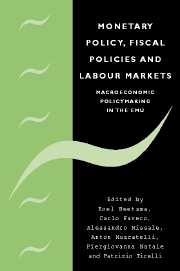Book contents
- Frontmatter
- Contents
- List of figures
- List of tables
- List of contributors
- Acknowledgements
- Editors' introduction
- Part I Monetary policy
- Part II Fiscal policies
- 5 The interaction between monetary and fiscal policies in a monetary union: a review of recent literature
- 6 Independent or coordinated? Monetary and fiscal policy in EMU
- 7 Interaction of fiscal policies in the euro area: how much pressure on the ECB?
- 8 The macroeconomic impact of different speeds of debt stabilisation in EMU
- 9 Fiscal shocks and policy regimes in some OECD countries
- 10 Monetary and fiscal policy interactions over the cycle: some empirical evidence
- Part III Labour markets
- Index
7 - Interaction of fiscal policies in the euro area: how much pressure on the ECB?
from Part II - Fiscal policies
Published online by Cambridge University Press: 22 September 2009
- Frontmatter
- Contents
- List of figures
- List of tables
- List of contributors
- Acknowledgements
- Editors' introduction
- Part I Monetary policy
- Part II Fiscal policies
- 5 The interaction between monetary and fiscal policies in a monetary union: a review of recent literature
- 6 Independent or coordinated? Monetary and fiscal policy in EMU
- 7 Interaction of fiscal policies in the euro area: how much pressure on the ECB?
- 8 The macroeconomic impact of different speeds of debt stabilisation in EMU
- 9 Fiscal shocks and policy regimes in some OECD countries
- 10 Monetary and fiscal policy interactions over the cycle: some empirical evidence
- Part III Labour markets
- Index
Summary
Introduction
Since the Helsinki European Council of December 1999, a process of increased coordination of fiscal policies in the area of the euro seems to be on its way. In this chapter I examine this process from the point of view of the independence of the European Central Bank (ECB).
The interaction of the governments and the ECB is addressed in a game theoretical framework. First, the conditions under which the national governments are able to put pressure on the ECB are made explicit. Then the main question is addressed: would greater fiscal coordination reduce or increase the capacity of the monetary authority to target long-run inflation?
Formal and informal, discretional (positive) and rule-based (negative) coordination and their interactions are examined as possible solutions of the game. I conclude that the main point is not how much fiscal coordination there is, but the form it takes. It turns out that a mix of informal fiscal coordination and binding rules is the one that best preserves the independence of the ECB.
In the present chapter I try to determine which kind of coordination would allow the ECB to pursue its statutory goal of price stability. I start from the definition of ‘best environment’ as the one in which the ECB does not need to intervene to counteract exogenous or policy induced shocks. In such an ideal world, fiscal policy stabilises national output and unemployment while the central bank takes care of the common price stability.
- Type
- Chapter
- Information
- Monetary Policy, Fiscal Policies and Labour MarketsMacroeconomic Policymaking in the EMU, pp. 157 - 190Publisher: Cambridge University PressPrint publication year: 2004
- 1
- Cited by



